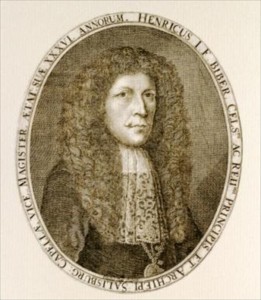 Heinrich Biber utilized brass, including trombone, fairly extensively. I recently added the following 9 entries, with information culled from Eric Chafe’s book, The Church Music of Heinrich Biber, to the Trombone History Timeline (17th century, 2nd half).
Heinrich Biber utilized brass, including trombone, fairly extensively. I recently added the following 9 entries, with information culled from Eric Chafe’s book, The Church Music of Heinrich Biber, to the Trombone History Timeline (17th century, 2nd half).
1673—Salzburg, Austria: Heinrich Biber calls for 3 trombones (the only winds in the piece) in his Lux Perpetua (Chafe 87, 237).
1674—Salzburg, Austria: Heinrich Biber’s polychoral mass, Missa Christi Resurgentis, calls for 3 trombones (Chafe 84, 234).
1674—Salzburg, Austria: Heinrich Biber’s Vesperae a 32 calls for 3 trombones (Chafe 119).
1682—Salzburg, Austria: Heinrich Biber (1644-1704) calls for 4 trombones in his Missa (“Salisburgenis”), including a “Crusifixus” scored for 4 bass voices and trombones (Collver 91; Chafe 50).
1690—Salzburg, Austria: After this date, Heinrich Biber calls for 3 trombones in his offertorium, Ne Cedite (Chafe 238).
1690—Salzburg, Austria: After this date, Heinrich Biber utilizes 3 trombones in an independent style (as opposed to colla parte) in his Requiem a 15 (Chafe 109).
1696—Salzburg, Austria: Heinrich Biber utilizes 3 trombones, colla parte, in his Missa S. Henrici (Chafe 95, 234).
1698—Salzburg, Austria: Heinrich Biber calls for 3 trombones in his Missa Alleluia (Collver 91; Chafe 233).
c. 1700—Salzburg, Austria: Heinrich Biber’s Litania de S. Josepho a 20 calls for 3 trombones (Chafe 179).